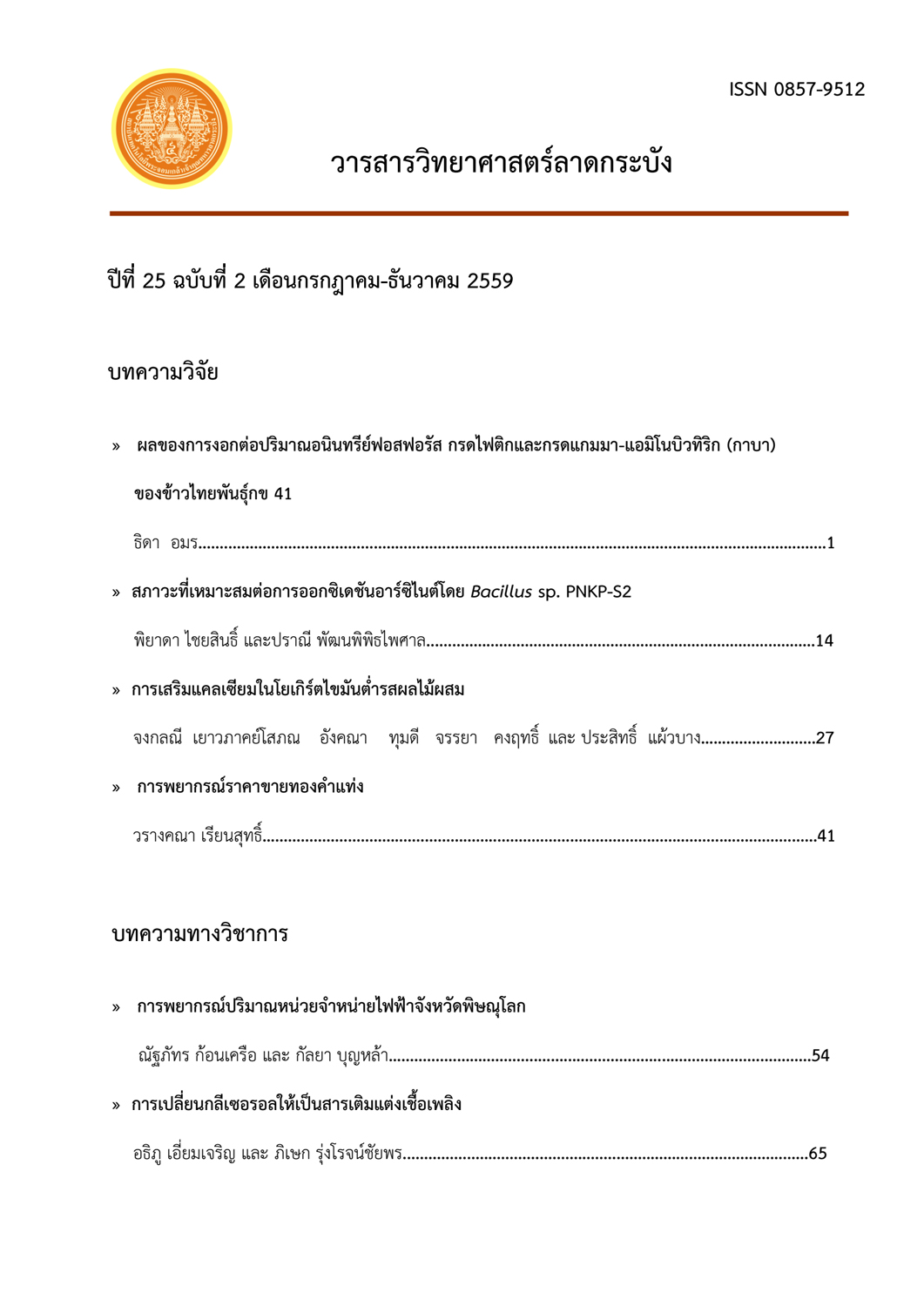การเสริมแคลเซียมในโยเกิร์ตไขมันต่ำรสผลไม้ผสม
Main Article Content
Abstract
บทคัดย่อ
การเสริมแคลเซียมแอล-แลคเตทเพนทะไฮเดรทในโยเกิร์ต ระดับ 0, 400, 600 และ 800 มิลลิกรัม/100 มิลลิลิตร (ควบคุมและเสริมแคลเซียม 3 ระดับ) มีปริมาณธาตุแคลเซียมในโยเกิร์ตทั้ง 4 กลุ่มคือ 130, 176, 191 และ 207 มิลลิกรัม/100 มิลลิลิตร ตามลำดับ ปริมาณแคลเซียมในโยเกิร์ตเสริมธาตุแคลเซียมมีสูงกว่ากลุ่มควบคุมคิดเป็น 35%, 47% และ 58% การเสริมแคลเซียมในโยเกิร์ตระดับ 400 มิลลิกรัม/100มิลลิลิตร มีรสชาติดีที่สุดแต่ไม่แตกต่างจากกลุ่มอื่น การทรงตัวและเนื้อสัมผัสสูงสุดในโยเกิร์ตเสริมแคลเซียม 400 มิลลิกรัม/100 มิลลิลิตร แต่ไม่แตกต่างจากกลุ่มควบคุม โยเกิร์ตทั้ง 4 กลุ่มไม่มีผลต่อค่าความเป็นกรดในวันที่ 1, 7 และ 14 วันของการเก็บรักษา ในวันที่ 1 และวันที่ 14 ของการเก็บรักษาพบว่าโยเกิร์ตเสริมแคลเซียม 400 มิลลิกรัม/100 มิลลิลิตร และกลุ่มควบคุมมีความหนืดสูงสุดและไม่แตกต่าง แต่แตกต่างอย่างมีนัยสำคัญจากโยเกิร์ต เสริมแคลเซียมในกลุ่มอื่นๆ สำหรับในวันที่ 7 ของการเก็บรักษาโยเกิร์ตเสริมแคลเซียม 400 มิลลิกรัม/100 มิลลิลิตร มีความหนืดสูงสุด และแตกต่างอย่างมีนัยสำคัญ (P<0.05) จากโยเกิร์ตทุกกลุ่ม จำนวนแลคโทบาซิลลัสสูงในสัปดาห์แรกของการเก็บรักษาทุกกลุ่มโยเกิร์ตและลดจำนวนลงในสัปดาห์ที่สามของการเก็บรักษา และมีระดับต่ำกว่าที่แนะนำ แต่การเสริมแคลเซียมใน โยเกิร์ต 400 มิลลิกรัม/100 มิลลิลิตร ในสัปดาห์ที่ 3 ของการเก็บรักษายังคงมีจำนวนแลคโทบาซิลลัสอยู่ในระดับสูง (1.55 x 108 CFU/g หรือ 8.19 log10 Lactobacillus counts, CFU/g) และพอเพียงตามที่แนะนำให้รับประทานต่อวัน ดังนั้นการเสริมแคลเซียมแลคเตท ในโยเกิร์ตระดับ 400 มิลลิกรัม/100 มิลลิลิตร เป็นระดับเหมาะสมและแนะนำสำหรับการเสริมในอุตสาหกรรมการผลิตโยเกิร์ต
คำสำคัญ : โยเกิร์ต การเสริมแคลเซียม
Abstract
Yogurt samples were prepared after fortification of pasteurized milk by addition of
four level (0, 400, 600 and 800 mg per 100 mL of milk) of calcium L-lactate
pentahydrate. Calcium measurement of control (0 mg per 100 mL of milk) and calcium-fortified fruit yogurts were 130, 176, 191 and 207 mg, and calcium fortification at these level resulted in 0%, 35%, 47% and 58% increases in calcium content of yogurts respectively. Sensorial evaluation shows that there were no significant differences
(P>0.05) in the flavor and overall acceptance of the control and calcium-fortified fruit yogurts. Yogurt with calcium fortification at 400 mg per 100 mL of milk got the highest scores for smoothness perception and body/texture characteristics and not significantly different (P>0.05) from control but had higher (P<0.05) than the yogurt with calcium fortification at 600 and 800 mg per 100 mL of milk. pH of control and calcium-fortified fruit yogurt did not show any statistical difference (P>0.05) on 1st, 7th and 14th day during storage. On 1st and 14th day during storage, the viscosity of control yogurt and yogurt with calcium fortification at 400 mg per 100 mL of milk were significantly (P<0.05) higher than the viscosity of the remaining yogurts. On 7th day during storage, the viscosity of yogurt with calcium fortification at 400 mg per 100 mL of milk were significantly (P<0.05) higher than the viscosity of the remaining yogurts. On the first week during storage all yogurt samples had the highest log10Lactobacillus counts and average viable cell counts of Lactobacillus tended to decrease with storage time or on the third week during storage and less than 108–109 cells daily recommended intake. The level of Lactobacillus count in yogurt with calcium fortification at 400 mg per 100 mL of milk on the end of the 21 th day of storage had been maintained high (1.55 x 108 CFU/g or 8.19 log10 Lactobacillus, CFU/g) and been sufficient for recommended dietary allowance (RDA). Yogurt with calcium fortification at 400 mg per 100 mL of milk is the most appropriate and recommended level for commercial manufacturer.
Keywords: yogurt, calcium fortification

